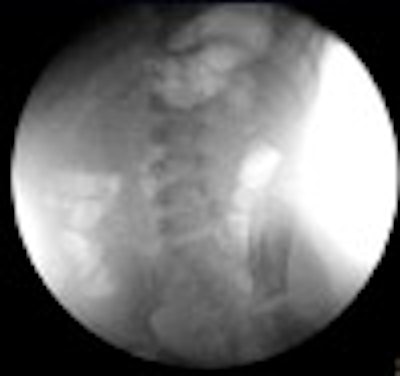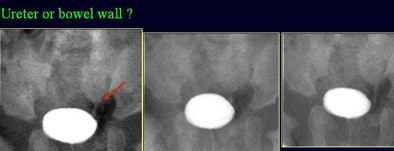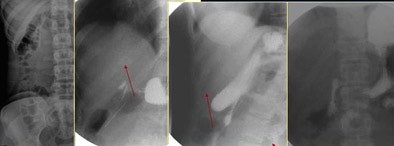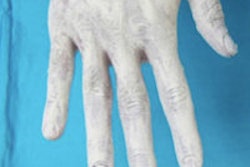
If you've ever watched a fluoroscopy study fly by and muttered something less printable than "Wait -- what was that again?" you may not be alone. Considering how fast physiologic processes happen, a little instant-replay action could go a long way toward nailing the diagnosis.
But until recently, the only way to learn about the UFO in question has been to refluoro the patient and take another look -- and in doing so, substantially increase the radiation dose.
The last image hold (LIH) feature available on most radiography and fluoroscopy (R/F) systems can be helpful, but often one image isn't enough for a good look at the pathology or dynamic process being documented.
How about a video? Researchers from Israel have found that a software feature known as last fluoroscopy hold (LFH) (CMT Medical Technologies, Yoqneam Ilit, Israel) can dramatically reduce the need for another pass at the patient by simply replaying on demand the last few hundred images acquired. The program stores the last current sequence of fluoroscopy images in a cyclic buffer memory for instant replay, editing, and storage in R/F systems.
|
Having trouble viewing this clip? Click here to view full-size clip or to change format. |
| Last fluoroscopy hold allows the radiologist to replay fluoroscopy sequences to get a second look without re-exposing the patient, thereby reducing dose and saving time. This video shows an upper GI barium series in a patient postgastric banding. There is a narrowing just beyond the ring that can be seen only for a split second, and then is hidden from view due to barium filling the rest of the stomach. Although this study was performed in a young adult and not a young child, it depicts the "instant replay" benefit of last fluoroscopy hold. All videos and images courtesy of Dr. Michalle Soudack and Dr. Aviv Hirschenbein. |
At the 2006 RSNA meeting in Chicago, Dr. Michalle Soudack from the Rambam Health Care Campus in Haifa, Israel, discussed her group's study of radiologists who used the feature on pediatric patients undergoing fluoroscopy.
Time and again the use of LFH made the diagnosis easier, sparing their young patients the radiation dose that would have otherwise been needed to make the diagnosis, according to Soudack.
|
Having trouble viewing this clip? Click here to view full-size clip or to change format. |
| Normal voiding cystourogram. |
"There is substantial evidence that children are more sensitive to ionizing radiation. Therefore it is of utmost importance to adhere to the ALARA (as low as reasonably achievable) principle," she said in her RSNA presentation. "Doctors also know there are certain fluoroscopic exams that have no accepted worldwide alternative test -- such as voiding cystourethrography to rule out a fistula, postsurgical leaks, swallow tests, and intussusception induction, to just to name a few."
 |
| A white strip appeared superolaterally to the bladder in a voiding cystourogram study. The physicians were unsure whether it represented reflux or bowel wall. Instead of repeat fluoroscopy, they repeated the run in LFH mode, which clearly showed that the anatomy was bowel wall. |
There are also several ways to reduce radiation doses in these studies, she said -- for example, by carefully reviewing the appropriateness criteria for each exam, using proper filters, choosing pulsed rather than continuous fluoroscopy, and using software such as last image hold to reduce the radiation burden.
"While we're doing exams, we have to reduce exposure time and that's where last fluoroscopic hold may play a role," Soudack said.
LFH stores the last 250-500 images acquired in a cyclic buffer memory during any fluoroscopic sequence. "The images can be viewed by instant replay at the patient's side or at a remote unit. The images can be stored and edited on most PACS units, and this feature can be integrated into most digital or R/F systems," she said.
Before embarking on the clinical study, the researchers performed an in vitro evaluation of the LFH feature in two labs. The tests consisted of random arm movements in a fluoroscopic field-of-view with a circle in the center. Volunteers had to capture and record an activity with the arm in the circle using both last image hold and last fluoroscopic hold.
"In this evaluation, 100% of the tips of the circle were captured by last fluoroscopic hold, as compared to 36% by last image hold," Soudack said. And the average fluoro time to capture them was shorter by a statistically significant margin.
Lead investigator Soudack with Dr. Aviv Hirschenbein (CMT); Udi Dafni, Ph.D. (CMT); and Dr. Ahuva Engel aimed to assess the clinical value of last fluoroscopic hold in fluoroscopic examinations of children with regard to image quality and radiation dose reduction.
Over a three-month period, Soudack's group performed 46 fluoroscopic exams on 44 pediatric patients. LFH was used whenever LIH did not provide an adequate diagnostic image or when a dynamic process, such as swallowing or urination, was too fast or didn't last long enough to permit clinical judgment and conclusions.
All exams were performed by an experienced dedicated pediatric radiologist. No direct comparison was made to the use of LFH versus no use to avoid the possibility of unnecessary radiation, and therefore the study did not include a control group. Despite this limitation, the researchers considered it "morally and ethically wrong not to use a feature that potentially reduces exposure time when we have it (available)," Soudack said.
In all, LFH was employed in 15 (32%) of the fluoro studies. LFH obviated the need for repeat fluoroscopy in three upper GI examinations and one voiding cystourethrography study (VCUG). The other nine (20%) exams were all voiding VCUGs. In five of these, LFH provided images that enabled superior depiction of reflux grade as compared to the image captured by LIH, Soudack said.
 |
| Study results showed that LFH was needed for a second look in nearly a third of all pediatric fluoro studies, potentially sparing the patients additional radiation exposure. |
Using the technique for central venous line fluoroscopy, "we could concentrate on the dynamic event and scroll through the images later," she said. In the VCUG studies, LFH enabled better definition of the reflux grade.
In one case, a 16-year-old girl in their care had swallowed a hat pin, "and by plain films (we) couldn't decide what part of the intestinal tract it was in," Soudack said. "We ... let the duodenum fill with barium and rotated her on the fluoro table." Repeat viewing with LFH allowed the doctors to determine that the hat pin was adjacent to the duodenum without another fluoro pass, she said.
 |
| An upper GI barium study was performed on a 16-year-old girl who had swallowed a hat pin. By plain films (above), the physicians could not determine which part of the gastrointestinal tract it was lodged in. The patient was given barium and rotated under fluoroscopic control to make sure the pin was in the duodenum and accessible to endoscopic removal. Review with LFH (below) made it clear the pin was in the duodenum, and endoscopy proved the diagnosis correct. |
 |
"LFH is a reliable new feature that can be integrated into most systems," Soudack concluded. "It probably reduces exposure time and probably increases the number of diagnostic images. It can record physiologic dynamic events, and we used it in almost 30% of pediatric fluoroscopy patients, especially upper GI."
By Eric Barnes
AuntMinnie.com staff writer
January 9, 2006
Related Reading
CARS suite of the future sees key role for image-guided intervention, June 23, 2005
Associations set benchmarks for x-ray, CT, fluoro doses, April 14, 2005
Fluoroscopy safety demands a plan, October 11, 2001
Low-dose CT fluoroscopy minimizes interventional exposure, July 30, 2001
Copyright © 2007 AuntMinnie.com



















